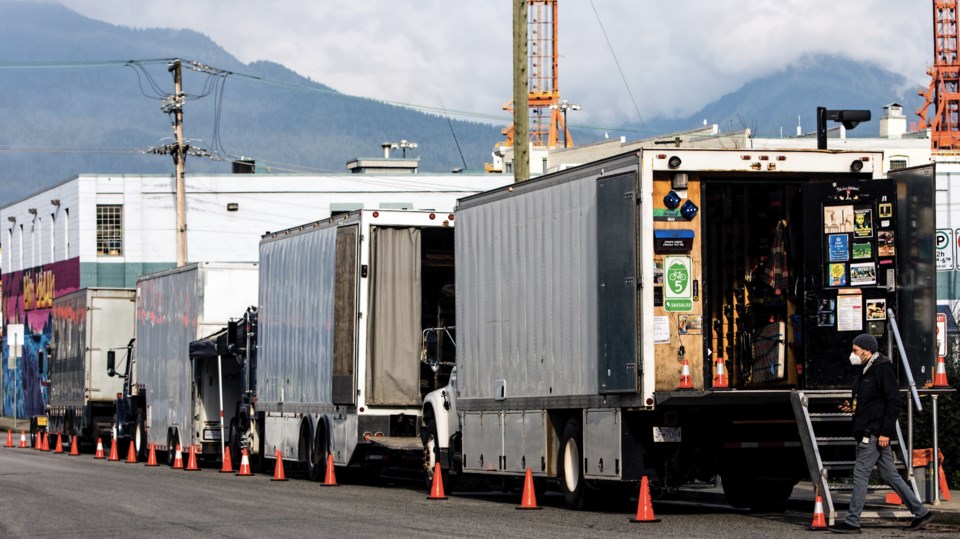The Canadian dollar, which is at its lowest point against the U.S. dollar since June 2020, has been a significant boon for B.C.’s film industry in its continued postCOVID resurgence, officials say.
The industry contributed almost $5 billion to B.C.’s economy last year. It also has feature-length film production and several other sub-sectors that are closely related to Hollywood studio spending. As such, the falling loonie – which reached US$0.72 on Oct. 1 – has re-enforced one of Metro Vancouver’s top advantages when it comes to attracting projects, one official said.
“The majority of our industry is run through the U.S. dollar, whether you shoot in foreign jurisdictions outside the United States or Canada,” said Shawn Williamson, founder and chair of Burnaby’s Brightlight Pictures Inc. “So most of our budgets are U.S.-dollar budgets. There are three or four elements that foreign producers – whether they are American, English or European – always look at when they are deciding whether or not to come to Vancouver. Currency is always one of them. So we are an industry that generally benefits from a lower Canadian dollar.”
Brightlight, which helped produce major Hollywood features such as Every Breath You Take (2021) and TV series like ABC’s The Good Doctor (2021), has been extraordinarily busy since a pause in the initial months of the COVID-19 pandemic. But the pandemic also brought on a massive wave of demand from consumers staying at home and created a huge appetite for shows and movies on streaming platforms.
Prem Gill, CEO of Creative BC, the province’s “industry catalyst” for the film sector, said Brightlight’s experience isn’t isolated. Gill said B.C. had 500 productions in 2021. Pre-pandem ic, production numbers could have been as low as 350. Currently, there are about 40 productions in the province – not including additional work such as visual effects and animation, Gill added.
“Pre-pandemic productions can range up towards 500, as well, so it’s been pretty steady and consistent,” she said. “But in 2021, there was definitely a bit of a surge because there was a backlog of things all over the world. And when things resumed, people continued to see Vancouver, Metro Vancouver and B.C. as a place they want to come to, because we have a long established industry of 40-plus years – along with the infrastructure and talent base.”
The presence of that talent base in B.C., more than the increasingly favourable exchange rate, is the key draw for investment and productions to the area, said Brian Hamilton, principal and executive producer at Vancouver’s Omnifilm Entertainment Ltd.
Hamilton has been heavily involved in building B.C.’s film industry ecosystem since the company’s founding in 1979. Hamilton also co-founded the Pacific Screenwriting Program with funding partners that include Netflix Inc. (Nasdaq:NFLX), and he said the talent base in Vancouver, not a cheaper currency, is the business driver.
“We produce primarily television series, rather than feature films – which are projects that are completed within a few months,” he said. “In terms of filming, they are more sensitive to fluctuations in the U.S. dollar than filming for television series, because when a studio decides to make Vancouver the home of a new series, that’s a decision that crosses many years. So decision-makers can’t look uniquely at the exchange rate because that value will change over time.”
But Hamilton confirmed that the industry has come out of the pandemic in much better shape than others. Again, he attributed that to the human capital in B.C., adding that it is the No. 1 challenge the province has to address to ensure future inbound productions.
“We are in expansion mode, and we’ve made a couple of key hires in the last month,” Hamilton said. “But there’s more competition for the talent pool that exists here.… Yes, our costs are lower, and the tax credit incentives by both levels of government are important. But while the exchange rate is good news, people are choosing Vancouver because of the crews, and that comes back to our human assets – which are world-class.”
Gill and Williamson agree that a variety of factors – including the exchange rate and B.C.’s film production proficiency – create a welcoming ecosystem for productions.
“The exchange rate can certainly work to the advantage of any jurisdiction in making it more lucrative [to film there],” Gill said. “But if we didn’t have the almost three million square feet of studio space and the thousands of people in the industry, … you can’t attract productions. And you can’t create that capacity overnight.… We have been hard at work, and we will continue to work to create an environment that makes productions successful. You have to keep your eyes on all things at all times.”
Williamson added that there is another piece to the puzzle: Productions from beyond the United States. The recent currency fluctuations have largely been triggered by a sharp drop in the British pound sterling – with the Canadian dollar almost reaching £0.70 in late September, its highest point against the British currency in at least a decade.
The higher Canadian dollar on that front may hurt B.C.’s ability to attract film investment from across the Atlantic, Williamson said, something that hampers B.C.’s capacity to grow its industry overseas.
“I would like to see a stronger British pound, because we do have British partners who work with us,” he said. “We would like to see them be strong financially and be successful, to be able to come and spend U.K. pounds in Canada. We just completed a huge project with British partners, so hopefully things rebound quickly.”




